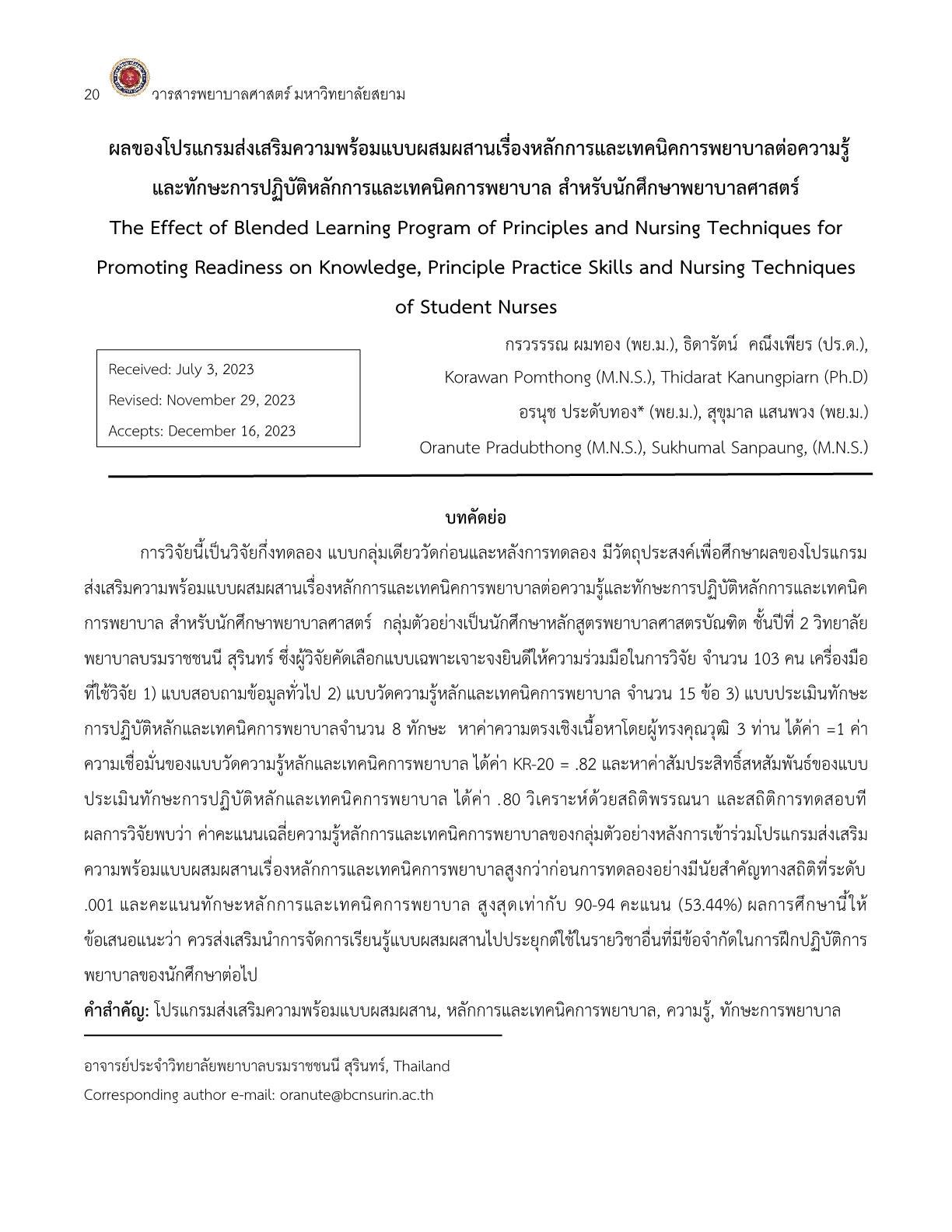ผลของโปรแกรมส่งเสริมความพร้อมแบบผสมผสานเรื่องหลักการและเทคนิคการพยาบาลต่อความรู้ และทักษะการปฏิบัติหลักการและเทคนิคการพยาบาล สำหรับนักศึกษาพยาบาลศาสตร์
คำสำคัญ:
โปรแกรมส่งเสริมความพร้อมแบบผสมผสาน, หลักการและเทคนิคการพยาบาล, ความรู้, ทักษะการพยาบาลบทคัดย่อ
การวิจัยนี้เป็นวิจัยกึ่งทดลอง แบบกลุ่มเดียววัดก่อนและหลังการทดลอง มีวัตถุประสงค์เพื่อศึกษาผลของโปรแกรมส่งเสริมความพร้อมแบบผสมผสานเรื่องหลักการและเทคนิคการพยาบาลต่อความรู้และทักษะการปฏิบัติหลักการและเทคนิคการพยาบาล สำหรับนักศึกษาพยาบาลศาสตร์ กลุ่มตัวอย่างเป็นนักศึกษาหลักสูตรพยาบาลศาสตรบัณฑิต ชั้นปีที่ 2 วิทยาลัยพยาบาลบรมราชชนนี สุรินทร์ ซึ่งผู้วิจัยคัดเลือกแบบเฉพาะเจาะจงยินดีให้ความร่วมมือในการวิจัย จำนวน 103 คน เครื่องมือที่ใช้วิจัย 1) แบบสอบถามข้อมูลทั่วไป 2) แบบวัดความรู้หลักและเทคนิคการพยาบาล จำนวน 15 ข้อ 3) แบบประเมินทักษะการปฏิบัติหลักและเทคนิคการพยาบาลจำนวน 8 ทักษะ หาค่าความตรงเชิงเนื้อหาโดยผู้ทรงคุณวุฒิ 3 ท่าน ได้ค่า =1 ค่าความเชื่อมั่นของแบบวัดความรู้หลักและเทคนิคการพยาบาล ได้ค่า KR-20 = .82 และหาค่าสัมประสิทธิ์สหสัมพันธ์ของแบบประเมินทักษะการปฏิบัติหลักและเทคนิคการพยาบาล ได้ค่า .80 วิเคราะห์ด้วยสถิติพรรณนา และสถิติการทดสอบทีผลการวิจัยพบว่า ค่าคะแนนเฉลี่ยความรู้หลักการและเทคนิคการพยาบาลของกลุ่มตัวอย่างหลังการเข้าร่วมโปรแกรมส่งเสริมความพร้อมแบบผสมผสานเรื่องหลักการและเทคนิคการพยาบาลสูงกว่าก่อนการทดลองอย่างมีนัยสำคัญทางสถิติที่ระดับ .001 และคะแนนทักษะหลักการและเทคนิคการพยาบาล สูงสุดเท่ากับ 90-94 คะแนน (53.44%) ผลการศึกษานี้ให้ข้อเสนอแนะว่า ควรส่งเสริมนำการจัดการเรียนรู้แบบผสมผสานไปประยุกต์ใช้ในรายวิชาอื่นที่มีข้อจำกัดในการฝึกปฏิบัติการพยาบาลของนักศึกษาต่อไป
เอกสารอ้างอิง
กัลยาณี ตันตรานนท์, วิลาวัณย์ เตือนราษฎร์ และธานี แก้วธรมา. (2561). การประยุกต์ใช้แนวคิดการจัดการเรียนรู้แบบผสมผสานในกระบวนวิชาวิทยาการระบาด. พยาบาลสาร, 45(1), 100-109.
จรูญลักษณ์ ป้องเจริญ, ยุคลธ์ เมืองช้าง, เรวดี โพธ์รัง และดารินทร์พนาสันต์. (2565). ผลการจัดการเรียนรู้โดยใช้บทเรียนออนไลน์ใน Google Classroom ต่อผลสัมฤทธิ์ทางการเรียนและความพึงพอใจของนักศึกษาพยาบาลศาสตรบัณฑิตชั้นปีที่ 2 ในวิชาการพยาบาลขั้นพื้นฐาน. วารสารพยาบาลศาสตร์ มหาวิทยาลัยสยาม, 25(45),54-71
ดนัยศักดิ์ กาโร. (2564). ผลการจัดการเรียนการสอนแบบผสมผสานด้วยบทเรียนออนไลน์แบบเปิดสำหรับมหาชนในรายวิชาการประยุกต์ใช้เทคโนโลยีทางการศึกษาออนไลน์. การประชุมวิชาการระดับชาติมหาวิทยาลัยราชภัฏภูเก็ต ครั้งที่ 13. ภูเก็ต :มหาวิทยาลัยราชภัฏภูเก็ต.
ปิยนุช ชูโต, ศรีมนา นิยมค้า และจันทร์ฉาย โยธาฤทธิ์. (2557). ผลการจัดการเรียนการสอนแบผสมผสานเพื่อเสริมสร้างสมรรถนะทางเทคโนโลยีสารสนเทศเพื่อสนับสนุนการฝึกปฏิบัติการพยาบาลของนักศึกษาพยาบาลศาสตร์ ชั้นปี ที่ 4 มหาวิทยาลัยเชียงใหม่. วารสารพยาบาลและการศึกษา, 7(4), 156-167.
พีระนันท์ จีระยิ่งมงคล, พิมพ์ลดา อนันต์สิริเกษม, พลอยประกาย ฉลาดล้น และนวพร ดำแสงสวัสดิ์. (2565). ผลการจัดการเรียนรู้แบบผสมผสานต่อผลลัพธิ์การเรียนรู้ในรายวิชาปฏิบัติการพยาบาลครอบครัวและชุมชน 2 ภายใต้สถานการณ์ COVID–19. วารสารการพยาบาลและการศึกษา, 15(3), 71-81.
วรรณา ชัยชนะรุ่งเรือง. (2551). ผลของการเตรียมความพร้อมในการฝึกภาคปฏิบัติต่อความรู้ เจตคติ และทักษะในการพยาบาลบุคคลที่มีปัญหาสุขภาพ.สระบุรี: วิทยาลัยพยาบาลบรมราชนนี สระบุรี.
ศุภรัตน์ แจ่มแจ้ง, วิรดา อรรถเมธากุล และดวงแข พิทักษ์สิน. (2561). ผลของการเตรียมความพร้อมในการฝึกปฏิบัติการพยาบาลบนหอผู้ป่วยอย่างมีแบบแผนสำหรับนักศึกษาพยาบาลศาสตรบัณฑิตชั้นปีที่ 2 วิทยาลัยพยาบาลบรมราชชนนี ราชบุรี.วารสารวิทยาศาสตร์และเทคโนโลยี มหาวิทยาลัยอุบลราชธานี, 20(3), 147-163.
สุสัณหา ยิ้มแย้ม, อำไพ จารุวัชรพาณิชกุล, จันทรัตน์ เจริญสันติ, อภิรัช อินทรางกูร ณ อยุธยา, ปิยนุช ชูโต และนงลักษณ์ เฉลิมสุข. (2558). การพัฒนาการจัดการเรียนรู้แบบผสมผสานเพื่อพัฒนาทักษะการ เรียนรู้ในศตวรรษที่ 21 พยาบาลสาร, 42 (ฉบับพิเศษ), 129-140.
อภิชาติ อนุกูลเวช. (2555). การเรียนแบบผสมผสาน (Blended Learning). สืบค้น 10 ตุลาคม 2566 จาก http://www.chontech.ac.th/_abichat/1/index.php/option.html.
อภิรดี นันท์ศุภวัฒน์ และเรมวล นันท์ศุภวัฒน์. (2556). ความพึงพอใจและผลลัพธิ์ของการจัดการเรียนการสอนแบบผสมผสานในกระบวนวิชาภาวะผู้นำและการจัดการทางการพยาบาล. พยาบาลสาร, 40 (ฉบับพิเศษ), 47-60.
COMAS-QUINN. A. (2011) Learning to teach online or learning to become an online teacher: an exploration of teachers’ experiences in a blended learning course. European Association for Computer Assisted Language Learning, 23(3), 218–232. https://doi.org/10.1017/S0958344011000152,
Gagnon, M., Gagnon,J., Desmartis, M and Njoya M. (2013). The Impact of Blended Teaching on Knowledge, Satisfaction, and Self-Directed Learning in Nursing Undergraduates: A Randomized, Controlled Trial. Nursing Education Perspectives, 36 (4), 377-382.
Jeffrey, L. M., Milne, J., Suddaby. G., & Higgins, A. (2014). Blended learning: How teachers balance the blend of online and classroom components. Journal of Information Technology Education: Research, 13, 121-140. Retrieved from http://www.jite.org/documents/Vol13/JITEv13ResearchP121-140Jeffrey0460.pdf
Jokinen, P., & Mikkonen, I. (2013) Teachers’experiences of teaching in a blended learning environment. Nurse Education in Practice, 13, 524-528. doi.org/10.1016/j.nepr.2013.03.014

ดาวน์โหลด
เผยแพร่แล้ว
รูปแบบการอ้างอิง
ฉบับ
ประเภทบทความ
สัญญาอนุญาต
ลิขสิทธิ์ (c) 2023 วารสารพยาบาลศาสตร์ มหาวิทยาลัยสยาม

อนุญาตภายใต้เงื่อนไข Creative Commons Attribution-NonCommercial-NoDerivatives 4.0 International License.
เนื้อหาและข้อมูลที่เผยแพร่ในวารสารพยาบาลศาสตร์ มหาวิทยาลัยสยามถือเป็นข้อคิดเห็นและความรับผิดชอบของผู้นิพนธ์บทความโดยตรง
บทความ เนื้อหา ข้อมูล รูปภาพ ฯลฯ ที่ได้รับการเผยแพร่ในวารสารพยาบาลศาสตร์ มหาวิทยาลัยสยาม ถือเป็นลิขสิทธิ์ของวารสารพยาบาลศาสตร์ มหาวิทยาลัยสยาม หากบุคคลหรือหน่วยงานใดต้องการนำทั้งหมดหรือส่วนหนึ่งส่วนใดไปเผยแพร่หรือเพื่อกระทำการใด ๆ จะต้องอ้างอิงวารสารพยาบาลศาสตร์ มหาวิทยาลัยสยามทุกครั้ง


